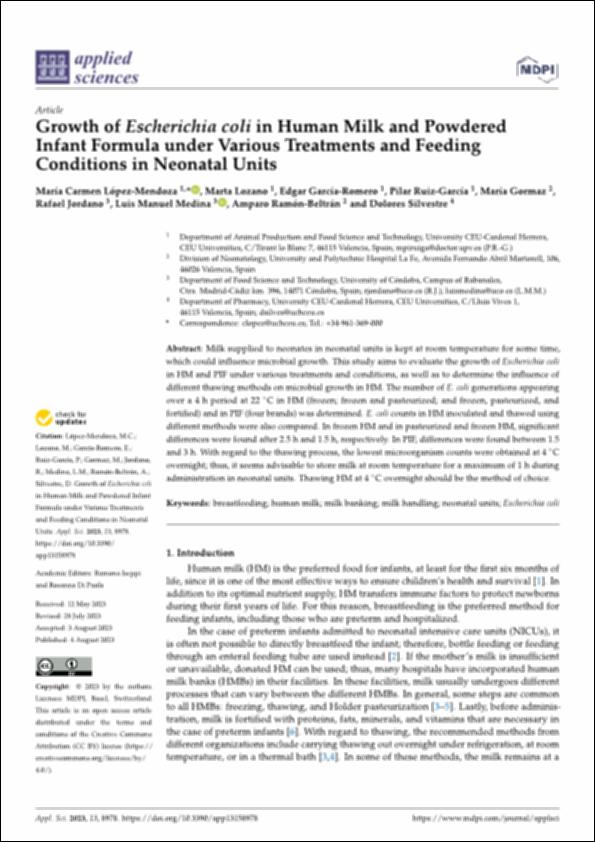Please use this identifier to cite or link to this item:
http://hdl.handle.net/10637/16279Growth of "Escherichia coli" in human milk and powdered infant formula under various treatments and feeding conditions in neonatal units
| Title: | Growth of "Escherichia coli" in human milk and powdered infant formula under various treatments and feeding conditions in neonatal units |
| Authors : | López Mendoza, María Carmen Lozano Fuentes, Marta García Romero, Edgar Ruiz García, Pilar Gormaz, María Jordano, Rafael Medina, Luis Manuel Ramón Beltrán, Amparo Silvestre Castelló, Dolores |
| Keywords: | Leche materna; Mother's milk; Lactancia materna; Breast feeding; Escherichia coli |
| Publisher: | MDPI |
| Citation: | López-Mendoza, M.C., Lozano, M., García-Romero, E., Ruiz-García, P., Gormaz, M., Jordano, R., Medina, L.M., Ramón-Beltrán, A., & Silvestre, D. (2023). Growth of "Escherichia coli" in human milk and powdered infant formula under various treatments and feeding conditions in neonatal units. Applied Sciences, 13, 8978. https://doi.org/10.3390/app13158978 |
| Abstract: | Milk supplied to neonates in neonatal units is kept at room temperature for some time, which could influence microbial growth. This study aims to evaluate the growth of Escherichia coli in HM and PIF under various treatments and conditions, as well as to determine the influence of different thawing methods on microbial growth in HM. The number of E. coli generations appearing over a 4 h period at 22 °C in HM (frozen; frozen and pasteurized; and frozen, pasteurized, and fortified) and in PIF (four brands) was determined. E. coli counts in HM inoculated and thawed using different methods were also compared. In frozen HM and in pasteurized and frozen HM, significant differences were found after 2.5 h and 1.5 h, respectively. In PIF, differences were found between 1.5 and 3 h. With regard to the thawing process, the lowest microorganism counts were obtained at 4 °C overnight; thus, it seems advisable to store milk at room temperature for a maximum of 1 h during administration in neonatal units. Thawing HM at 4 °C overnight should be the method of choice. |
| Description: | Este artículo pertenece al número especial "Microbiological Contamination: Latest Advances and Prospects". |
| URI: | http://hdl.handle.net/10637/16279 |
| Rights : | http://creativecommons.org/licenses/by/4.0/deed.es Open Access |
| ISSN: | 2076-3417 (Electrónico) |
| Issue Date: | 4-Aug-2023 |
| Center : | Universidad Cardenal Herrera-CEU |
| Appears in Collections: | Dpto. Producción y Sanidad Animal, Salud Pública Veterinaria y Ciencia y Tecnología de los Alimentos |
Items in DSpace are protected by copyright, with all rights reserved, unless otherwise indicated.


